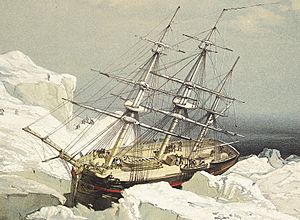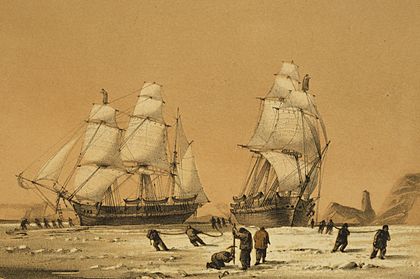HMS Investigator (1848) facts for kids

HMS Investigator stuck in ice in August 1851, depicted by the ship's artist Samuel Gurney Cresswell
|
|
Quick facts for kids History |
|
|---|---|
| Name | Investigator |
| Operator | Royal Navy |
| Builder | Scotts Shipbuilding Company |
| Cost | £25,337 |
| Acquired | February 1848 |
| Abandoned: | 3 June 1853 |
| General characteristics | |
| Class and type | Survey vessel |
| Tons burthen | 422–480 tonnes BOM |
| Length | 118 ft (36 m) |
| Beam | 28+1⁄4 ft (8.6 m) |
| Depth of hold | 18+11⁄12 ft (5.8 m) |
| Sail plan | Barque-rigged |
HMS Investigator was a special ship bought in 1848. Her main job was to search for Sir John Franklin's missing expedition. Franklin's team was trying to find the Northwest Passage, a sea route through the Arctic.
The Investigator made two trips to the icy Arctic region. Sadly, she got stuck in thick ice and had to be left behind in 1853. Her remains were found much later, in July 2010. This discovery happened near Banks Island in the Beaufort Sea. She was the fourth ship in the Royal Navy to be named Investigator.
Contents
Building a Ship for Arctic Ice
The Investigator was built in Greenock, Scotland, at a place called Scotts Shipbuilding and Engineering Company. She weighed about 422 tonnes. The British Navy bought her in February 1848.
Workers then prepared her for trips to the Arctic. This was done at Blackwall Yard on the River Thames. The ship was made extra strong to handle the ice. They used lots of strong wood like teak, English oak, and Canadian elm. They also added thick steel plates.
Inside, ten pairs of strong iron bars were put in the ship's lower part. More iron plates were added between the decks. To deal with heavy snow and ice, the upper decks were made extra thick with fir wood. Special windows were installed to let in more light and fresh air. A modern stove system, called Charles Sylvester's warming apparatus, kept the whole ship warm. This helped prevent dampness and kept the air fresh, even on the lowest deck.
Investigator's Arctic Journeys

In 1848, the Investigator joined HMS Enterprise. They were part of an expedition led by James Clark Ross. Their mission was to find Franklin's lost expedition. A scientist named Edward Adams was also on board the Investigator during this trip.
On their second journey, the Investigator was commanded by Robert McClure. The ship became trapped in the thick ice near Mercy Bay, which is next to Banks Island. She was stuck for almost three years. Because of this, the crew had to leave the ship on June 3, 1853.
The next year, sailors from HMS Resolute found the Investigator still frozen in the ice. They reported that she was in good shape, even though some water had gotten in during the summer thaw.
Unlike the mystery of what happened to Erebus and Terror, we know exactly why the Investigator was abandoned. Captain McClure wrote an official report about the journey. The ship's doctor, Alexander Armstrong, also wrote his own story in 1857. However, finding the exact spot where the ship sank was hard for over 150 years. This area is very cold and often covered in ice.
Stories and Legacy

The Inuit people have old stories about the Investigator. The abandoned ship became a source of metal for them. They used its copper and iron. When smaller boats from the ship were found on the shore, their metal nails were missing. One Inuit story from 1910 said that "one year she had still been on the beach and the next year she was gone without a trace."
When a Canadian scientist named Vilhjalmur Stefansson visited Mercy Bay in 1915, he couldn't find the ship's remains. He met Inuit people who had visited the wreckage. He thought there might be a link between the ship getting stuck and why there were no muskoxen on Banks Island at that time. He believed the Inuit might have hunted the muskoxen for food during their trips to and from the ship over 40 years. Today, muskoxen have returned to the island, and there are nearly 50,000 of them.
Finding the Shipwreck
In July 2010, a group of scientists and archaeologists from Parks Canada started looking for the sunken Investigator. They searched in Mercy Bay, at the northern tip of Aulavik National Park. This was the first time anyone had specifically searched for the ship.
The team arrived at Banks Island on July 22. Three days later, they began using sonar to scan the area. They used old Royal Navy records to guess where the ship might be. They quickly found the ship's remains. It was about 150 meters (about 492 feet) from the north shore of Banks Island. The ship's deck was about 8 meters (about 26 feet) below the water's surface.
A Parks Canada superintendent said the ship was found "sitting upright in silt." Its three masts were gone, probably broken off by the ice. The ship's body is partly buried in the mud. The very cold Arctic water has helped keep the outer deck from rotting quickly. There are no plans to bring the ship's remains to the surface. However, the team did send a special underwater robot to take pictures and check out the wreckage.

